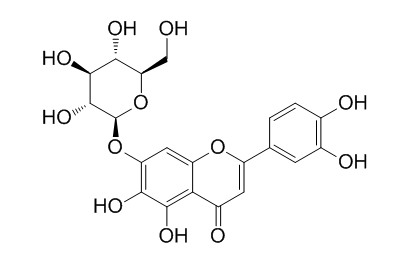6-Hydroxyluteolin 7-glucoside
Reference standards.
Inquire / Order:
manager@chemfaces.com
Technical Inquiries:
service@chemfaces.com
Tel:
+86-27-84237783
Fax:
+86-27-84254680
Address:
1 Building, No. 83, CheCheng Rd., Wuhan Economic and Technological Development Zone, Wuhan, Hubei 430056, PRC
Providing storage is as stated on the product vial and the vial is kept tightly sealed, the product can be stored for up to
24 months(2-8C).
Wherever possible, you should prepare and use solutions on the same day. However, if you need to make up stock solutions in advance, we recommend that you store the solution as aliquots in tightly sealed vials at -20C. Generally, these will be useable for up to two weeks. Before use, and prior to opening the vial we recommend that you allow your product to equilibrate to room temperature for at least 1 hour.
Need more advice on solubility, usage and handling? Please email to: service@chemfaces.com
The packaging of the product may have turned upside down during transportation, resulting in the natural compounds adhering to the neck or cap of the vial. take the vial out of its packaging and gently shake to let the compounds fall to the bottom of the vial. for liquid products, centrifuge at 200-500 RPM to gather the liquid at the bottom of the vial. try to avoid loss or contamination during handling.
Sci. Rep.2015, 14-23
Nat Commun.2025, 16(1):4121.
Molecules.2017, 22(12)
Molecules.2021, 26(2):E255.
Int J Mol Sci.2020, 21(19):7209.
Curr Res Food Sci.2024, 9:100827.
Front Microbiol.2023, 14:1232039.
Food Science and Human Wellness2022, 11(4):965-974
Toxicol Mech Methods.2021, 1-12.
Int J Oncol.2019, 55(1):320-330
Related and Featured Products
J Agric Food Chem. 2018 Feb 7;66(5):1167-1174.
Anti-Inflammatory and Antioxidant Activities from the Basolateral Fraction of Caco-2 Cells Exposed to a Rosmarinic Acid Enriched Extract.[Pubmed:
29345918 ]
The potential use of Origanum majorana L. as a source of bioavailable phenolic compounds, specifically rosmarinic acid (RA), has been evaluated.
METHODS AND RESULTS:
Phenolic bioavailability was tested using an in vitro digestion process followed by a Caco-2 cellular model of intestinal absorption. The HPLC-PAD-MS/MS analysis showed the main components in the extract were 6-hydroxyluteolin-7-O-glucoside(6-Hydroxyluteolin 7-glucoside ) and rosmarinic acid, followed by luteolin-O-glucoside. After digestion process, the amount of total phenolic compounds (TPC) only decreased slightly, although a remarkable reduction in RA (near 50%) was detected. Bioavailable fraction contained 7.37±1.39 mg/L digested extract of RA with small quantities of lithospermic acid and diosmin and presented an important antioxidant activity (0.89±0.09 mmol Trolox/L digested extract). Besides, this bioavailable fraction produced a significant inhibition in TNF-α, IL-1β and IL-6 secretion, using a human THP-1 macrophages model.
CONCLUSIONS:
Therefore, RA content in the basolateral compartment could play an important role in the antioxidant and anti-inflammatory activities found.
Phytochemistry, 1980, 19(8):1761-1766.
New 6-hydroxyflavonoids and their methyl ethers and glycosides from Neurolaena oaxacana.[Reference:
WebLink]
Six new and nine known flavonoids were obtained from Neurolaena oaxacana.
METHODS AND RESULTS:
The known flavonoids are 6-hydroxykaempferol 3,7-dimethyl ether, quercetagetin 3,7-dimethyl ether, quercetin 3-methyl ether, axillarin, nodifloretin, 6-Hydroxyluteolin 7-glucoside, kaempferol 3-glucoside, quercetagetin 7-glucoside and patulitrin. The new compounds are 6-hydroxykaempferol 3-methyl ether, quercetagetin 3,7-dimethyl ether 6-galactoside, quercetagetin 3-methyl ether 7-glucoside, the 6- and 7-glucosides of 6-hydroxykaempferol 3-methyl ether and quercetagetin 3-methyl ether 7-sulfate.



